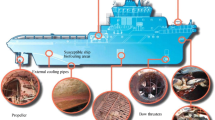Abstract
Localization and mapping are the fundamental ability for underwater robots to carry out exploration and searching tasks autonomously. This paper presents a novel approach to localization and mapping of a school of wirelessly connected underwater robotic fish (URF). It is based on both Cooperative Localization Particle Filter (CLPF) scheme and Occupancy Grid Mapping Algorithm (OGMA). Using the probabilistic framework, the proposed CLPF has the major advantage that no prior knowledge about the kinematic model of URF is required to achieve accurate 3D localization. It works well when the number of mobile beacons is less than four, which is the minimum number for some traditional localization algorithms. The localization result of CLPF is fed into OGMA to build the environment map. The performance of the proposed algorithms is evaluated through extensive simulation experiments, and results verify the feasibility and effectiveness of the proposed strategy.










Similar content being viewed by others
References
Akyildiz, I., Pompili, D., & Melodia, T. (2005). Underwater acoustic sensor networks: Research challenges. Ad Hoc Networks, 3(3), 257–279.
Baggio, A., & Langendoen, K. (2008). Monte carlo localization for mobile wireless sensor networks. Ad Hoc Networks, 6(5), 718–733.
Bahr, A., Leonard, J., & Fallon, M. (2009). Cooperative localization for autonomous underwater vehicles. The International Journal of Robotics Research, 28(6), 714–728.
Bailey, T., & Durrant-Whyte, H. (2006). Simultaneous localization and mapping (slam): Part ii. IEEE Robotics & Automation Magazine, 13(3), 108–117.
Dissanayake, M., Newman, P., Clark, S., Durrant-Whyte, H., & Csorba, M. (2001). A solution to the simultaneous localization and map building (slam) problem. IEEE Transactions on Robotics and Automation, 17(3), 229–241.
Durrant-Whyte, H., & Bailey, T. (2006). Simultaneous localization and mapping: Part i. IEEE Robotics & Automation Magazine, 13(2), 99–110.
Elfes, A. (1989). Occupancy grids: A probabilistic framework for robot perception and navigation. PhD thesis, Carnegie Mellon University.
Erol-Kantarci, M., Mouftah, H., & Oktug, S. (2011). A survey of architectures and localization techniques for underwater acoustic sensor networks. Communications Surveys and Tutorials, 13(3), 487–502.
Fallon, M., Papadopoulos, G., Leonard, J., & Patrikalakis, N. (2010). Cooperative auv navigation using a single maneuvering surface craft. The International Journal of Robotics Research, 29(12), 1461–1474.
He, B., Liang, Y., Feng, X., Nian, R., Yan, T., Li, M., et al. (2012). Auv slam and experiments using a mechanical scanning forward-looking sonar. Sensors, 12(7), 9386–9410.
Hong, X., Gerla, M., Pei, G., & Chiang, C. (1999). A group mobility model for ad hoc wireless networks. In Proceedings of the 2nd ACM international workshop on modeling, analysis and simulation of wireless and mobile systems (pp. 53–60), ACM.
Huang, Y., Liang, W., Yu, H., & Xiao, Y. (2008). Target tracking based on a distributed particle filter in underwater sensor networks. Wireless Communications and Mobile Computing, 8(8), 1023–1033.
Joordens, M., & Jamshidi, M. (2010). Consensus control for a system of underwater swarm robots. IEEE Systems Journal, 4(1), 65–73.
Knoll, A., & Prasad, R. (2012). Wireless robotics: A highly promising case for standardization. Wireless Personal Communications, 64, 611–617.
Kottege, N., & Zimmer, U. (2011). Underwater acoustic localization for small submersibles. Journal of Field Robotics, 28(1), 40–69.
Kumar, S., & Lobiyal, D. (2012). An advanced dv-hop localization algorithm for wireless sensor networks. Wireless Personal Communications, 1–21. doi:10.1007/s11277-012-0880-3.
Lee, P., Jeon, B., Kim, S., Choi, H., Lee, C., Aoki, T., & Hyakudome, T. (2004). An integrated navigation system for autonomous underwater vehicles with two range sonars, inertial sensors and doppler velocity log. In OCEANS’04. MTTS/IEEE TECHNO-OCEAN’04, IEEE (Vol. 3, pp. 1586–1593).
Lee, S., & Kim, K. (2012). Localization with a mobile beacon in underwater acoustic sensor networks. Sensors, 12(5), 5486–5501.
Lin, C. F., Chang, S. H., Lee, C. C., Wu, W. C., Chen, W. H., Chang, K. H., Lee, J., & Parinov, I. (2012). Underwater acoustic multimedia communication based on mimocofdm. Wireless Personal Communications (Online First).
Poncela, J., Aguayo, M., & Otero, P. (2012). Wireless underwater communications. Wireless Personal Communications, 64, 547–560.
Ribas, D., Ridao, P., Tardós, J., & Neira, J. (2008). Underwater slam in man-made structured environments. Journal of Field Robotics, 25(11–12), 898–921.
Rubinstein, R., & Kroese, D. (2007). Simulation and the Monte Carlo method (Vol. 707). Wiley, New York.
Tao, J., Zheng, Y., Xiao, C., & Yang, T. (2010). Robust mimo underwater acoustic communications using turbo block decision-feedback equalization. IEEE Journal of Oceanic Engineering, 35(4), 948–960.
Thrun, S., Burgard, W., Fox, D., et al. (2005). Probabilistic robotics (Vol. 1). Cambridge, MA: MIT press.
Yoerger, D., Jakuba, M., Bradley, A., & Bingham, B. (2007). Techniques for deep sea near bottom survey using an autonomous underwater vehicle. The International Journal of Robotics Research, 26(1), 41–54.
Yun, X., Bachmann, E., McGhee, R., Whalen, R., Roberts, R., Knapp, R., et al. (1999). Testing and evaluation of an integrated gps/ins system for small auv navigation. IEEE Journal Of Oceanic Engineering, 24(3), 396–404.
Acknowledgments
This research has been financially supported by National Natural Science foundation of China (Grant number 61165016) and by the University of Essex (Grant of Building Partnerships for Knowledge Exchange). Sen Wang and Ling Chen have been financially supported by Essex University Scholarship and China Scholarship Council. Our thanks also go to Robin Dowling for his technical support during the experiments.
Author information
Authors and Affiliations
Corresponding author
Rights and permissions
About this article
Cite this article
Wang, S., Chen, L., Hu, H. et al. Underwater Localization and Environment Mapping Using Wireless Robots. Wireless Pers Commun 70, 1147–1170 (2013). https://doi.org/10.1007/s11277-013-1106-z
Published:
Issue Date:
DOI: https://doi.org/10.1007/s11277-013-1106-z




